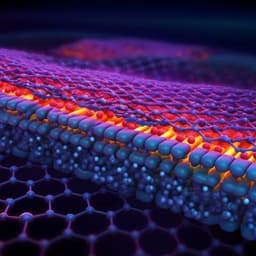
Engineering and Technology
Highly sensitive and reversible MXene-based micro quartz tuning fork gas sensors with tunable selectivity
W. Ding, J. Yu, et al.
This innovative research by Wei Ding, Jingjing Yu, Francis Tsow, Laxmi Raj Jaishi, Buddhi Sagar Lamsal, Rick Kittelson, Sarwar Ahmed, Parashu Kharel, Yue Zhou, and Xiaojun Xian showcases a groundbreaking MXene gas sensor that leverages mass-transduction principles for sensitive gas detection. With customizable selectivity for critical pollutants like CO, SO2, and NH3, this technology promises significant advancements in air quality monitoring and wearable devices.
~3 min • Beginner • English
Introduction
MXenes (Mn+1XnTx) are emerging 2D materials with metallic conductivity, tunable bandgap, mechanical flexibility, and hydrophilicity, making them attractive for sensors, energy, environmental, and biomedical applications. Their surface terminations (–O, –OH, –F) offer abundant active sites for chemical modification. MXene-based gas sensors reported to date (chemiresistive, capacitive, electrochemical, piezoresistive) largely rely on electrical conductivity for signal transduction. Exploring alternative transduction can unlock MXenes’ potential, enabling broader surface chemistry without degrading conductivity. Mass-transduction using a micro-quartz tuning fork (MQTF) is promising due to its high mechanical Q, low power, small size, stable resonance, and low cost. MQTF detects adsorption-induced mass changes via frequency shifts, with mass sensitivity on the order of ~1.3 ng per 1 Hz and linear response over appropriate mass ranges. High air pollution underscores the need for sensitive, selective, low-cost sensors for key pollutants CO (neutral), SO2 (acidic), and NH3 (basic). This work investigates MXene-coated MQTF gas sensors leveraging mass transduction and surface-functionalized Ti3C2Tx to tune sensitivity and selectivity toward CO, SO2, and NH3.
Literature Review
Prior MXene gas sensors have used electrical transduction (chemiresistive, capacitive, electrochemical, piezoresistive), capitalizing on MXenes’ high conductivity and surface activity. However, conductivity can be compromised by surface modifications intended to improve selectivity. The MQTF, widely used as a high-Q piezoelectric resonator and force sensor, offers a robust mass-sensitive platform with small size, low power, stability, and low cost. Literature indicates that MXene functional groups strongly influence gas adsorption energies and selectivity, with chemisorption often dominant and terminal groups (e.g., –OH, –F, –O) modulating interactions. Amine functionalization enhances affinity to acidic gases like SO2 through donor–acceptor chemistry, whereas fluorinated surfaces increase hydrophobicity and stability, potentially reducing nonspecific interactions. These insights motivate a mass-transduction MXene sensor where surface chemistry can be engineered without concern for electrical degradation, enabling tunable selectivity and sensitivity.
Methodology
Sensor principle: MQTF resonance frequency f0 depends on elastic constant K and effective mass meff. Mass loading produces a negative frequency shift Δf = −(f0/2m)Δm. Gas adsorption on a coated sensing layer changes mass and thus frequency proportionally to concentration in a linear regime.
MXene synthesis: Ti3C2Tx prepared by selectively etching Al from Ti3AlC2 (3 g, <100 μm) using premixed LiF (3 g) in 9 M HCl (30 ml), stirred 24 h at 35 °C. Suspension washed by centrifugation with DI water and ethanol to pH ~6, vacuum-filtered, and dried at 60 °C for 24 h.
Surface functionalization: Ti3C2Tx-NH2 via AEAPTMS grafting and Ti3C2Tx-F via FOTS. A 10/90 wt% water/ethanol mixture (360 ml water + 40 ml ethanol) was prepared; 800 mg Ti3C2Tx dispersed with nitrogen bubbling, stirred at 600 rpm, pH adjusted to 3.5 with acetic acid. AEAPTMS (1.6 g) added, reaction 8 h under nitrogen at specified temperatures (25, 35, or 60 °C) to yield Ti3C2Tx-NH2-25/-35/-60 after washing (ethanol, centrifugation 3500 rpm), filtration, and drying (60 °C, 24 h). Ti3C2Tx-F prepared similarly at 25 °C replacing AEAPTMS with FOTS. Functionalization rationale: FOTS introduces fluorinated groups for hydrophobicity, oxidation protection, increased interlayer spacing; AEAPTMS introduces free amine groups for acidic gas affinity and pH responsiveness.
Material characterization: XRD (Rigaku SmartLab) to confirm phase transformation from Ti3AlC2 to Ti3C2Tx and effects of functionalization; SEM (Hitachi S-4700 FESEM) for morphology; EDS mapping for elemental distribution (Ti, C, Si, N); XPS (Thermo VG Scientific Sigma Probe) for surface chemistry and element states (Ti 2p, C 1s, O 1s, F 1s, N 1s, Si 2p); FTIR to confirm functional groups (e.g., N–H).
Sensor fabrication: MQTFs (32768 Hz, 4 mm × 0.35 mm × 0.6 mm) were cleaned in ethanol. MXene ink: 40 mg MXene in 20 ml water, stirred 10 min; 1 ml drop placed on slide; MQTF tips were dip-coated at prongs’ bare regions, then dried in ambient conditions.
Gas testing: Custom chamber at room temperature; ambient air as purge; target gases (CO, SO2, NH3) introduced at 0.55 L min−1. Each cycle: 200 s analyte + 300 s purging. Concentration range: ~4–100 ppm. Frequency monitored with a custom circuit. Response time defined as time to 90% of saturated frequency change; recovery time to 10% after purging. Repeatability assessed with three cycles per concentration and multiple cycles at 100 ppm. Stability monitored over three weeks. Humidity and temperature monitored by Sensirion SHT3x_85; humidity effects characterized and mitigation strategies discussed (reference MQTF with humidity-sensitive coating, Nafion tubing, desiccants).
Modeling: Finite element model indicates linear Δf versus mass within a suitable range; high loadings may cause nonlinearity. Theoretical MQTF mass sensitivity ~1.3 ng/Hz; sensitivity can be improved by frequency accuracy enhancements.
Key Findings
- Mass-transduction MXene-MQTF sensors were fabricated using Ti3C2Tx coatings with tailored surface chemistries (–NH2, –F), enabling selective detection of CO, SO2, and NH3 at room temperature.
- Reversibility and repeatability: All sensors showed reversible responses with three repeated cycles per concentration over 4–100 ppm for CO, SO2, NH3. Cycling at 100 ppm SO2 demonstrated good repeatability.
- Response dynamics: For Ti3C2Tx-NH2 exposed to 100 ppm SO2, response and recovery times were ~112 s and ~153 s, respectively.
- Stability: Sensitivity change was less than 10% over three weeks.
- Sensitivity and selectivity (slopes of linear calibration, mHz ppm−1): Toward SO2, Ti3C2Tx = 5.71; Ti3C2Tx-NH2 = 11.18; Ti3C2Tx-F = 4.68. Ti3C2Tx-NH2 showed the highest response to SO2; Ti3C2Tx-F exhibited the strongest response to CO among tested MXenes; Ti3C2Tx-NH2 showed lower sensitivity to CO and NH3 consistent with weaker interactions.
- Tuning via functionalization: Amine groups enhanced SO2 adsorption via donor–acceptor chemistry; FOTS introduced C–F groups improving hydrophobicity and stability and leading to generally low, similar responses to SO2, NH3, CO; neutral CO adsorption on Ti3C2Tx-NH2 primarily via weak van der Waals interactions with low sensitivity.
- Temperature effect on functionalization: Increasing the AEAPTMS functionalization temperature from 25 °C to 60 °C increased SO2 sensitivity of Ti3C2Tx-NH2 sensors from 6.18 to 11.18 mHz ppm−1, attributed to higher surface –NH2 density, with caution about potential MXene degradation at higher temperatures.
- Humidity: Noted sensitivity to humidity with a linear effect; compensation strategies proposed (reference MQTF subtraction, Nafion tubing, desiccants).
- Practicality: MQTF transducers are compact (few mm) and low-cost (<$1) enabling integration into smart/wearable/IoT devices.
Discussion
The study addresses the need for alternative transduction mechanisms in MXene-based gas sensing by demonstrating a mass-transduction approach using MQTFs. Decoupling sensing from electrical conductivity allows extensive surface chemistry engineering without compromising signal readout, enabling tunable selectivity and sensitivity. Surface-functionalized Ti3C2Tx-NH2 exhibited strong affinity to acidic SO2 via donor–acceptor interactions with amines, yielding the highest SO2 sensitivity and reversible operation. Ti3C2Tx-F enhanced hydrophobicity and stability, aligning with low and similar responses to multiple gases and a comparatively stronger response to CO among the tested MXenes. Linear calibration over 4–100 ppm and stable performance over weeks underscore robustness. The response/recovery times are comparable to other MXene sensors, and further improvements are feasible via flow optimization and chamber dead-volume reduction. Humidity affects mass-based sensing but shows linear behavior amenable to compensation with reference channels or sample conditioning (Nafion, desiccants). The approach confirms theoretical predictions that MXene surface terminations govern adsorption energies and selectivity. Overall, mass-transduction MXene-MQTF sensors combine high-Q resonators with chemically tunable receptor layers to deliver sensitive, selective, reversible gas detection suitable for compact, low-cost deployment.
Conclusion
The work demonstrates MXene-coated MQTF mass-transduction gas sensors with tunable selectivity via surface chemistry engineering. Ti3C2Tx-NH2 sensors showed high selectivity and sensitivity to SO2, while Ti3C2Tx-F sensors responded most strongly to CO among the tested MXenes. Responses were linear and reversible across 4–100 ppm, with stable sensitivity over three weeks and practical response/recovery times. Increasing the aminosilane functionalization temperature enhanced SO2 sensitivity, illustrating adjustability through processing conditions. Decoupling sensing from conductivity broadens permissible MXene modifications, paving the way for high-performance, low-cost, compact sensors for air quality monitoring, wearables, IoT, and robotics. Future work could explore broader functional group libraries, optimization of functionalization protocols (balancing increased functional group density with MXene stability), integration of humidity compensation/reference channels, refinement of MQTF frequency accuracy to boost mass sensitivity, and system-level integration for multiplexed, portable sensing.
Limitations
- Humidity sensitivity inherent to mass-based transducers; although linear and correctable, it requires compensation (reference channel or sample conditioning) for accurate field measurements.
- Potential nonlinearity at high mass loadings on MQTF prongs, implying a practical coating thickness/coverage limit.
- Functionalization temperature increases sensitivity but may accelerate Ti3C2Tx degradation due to dissolved oxygen in water, indicating a trade-off between surface group density and material stability.
- Response/recovery times are influenced by gas flow rate and chamber dead volume; system design impacts dynamic performance.
- Detailed detection limits and long-term drift beyond three weeks were not reported in the text provided.
Related Publications
Explore these studies to deepen your understanding of the subject.







